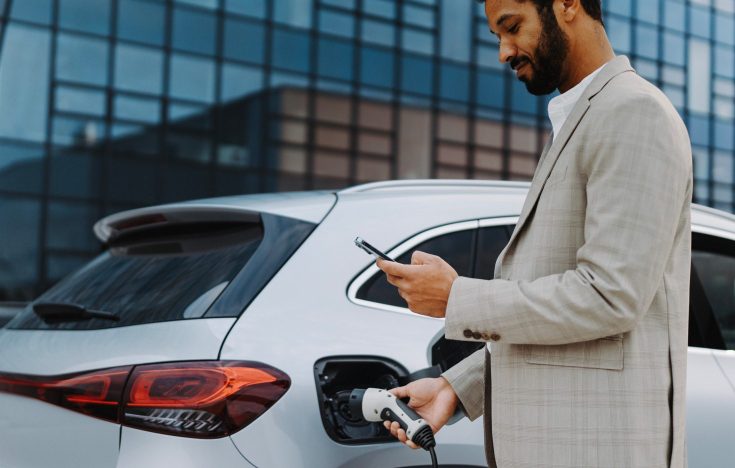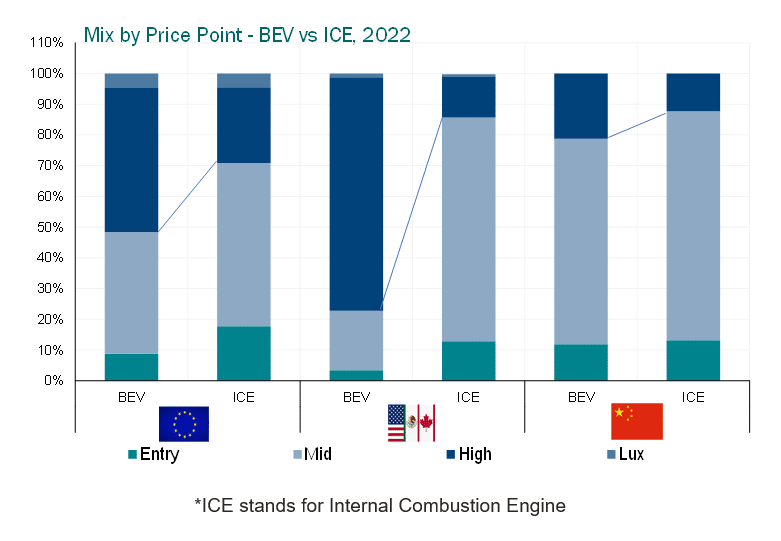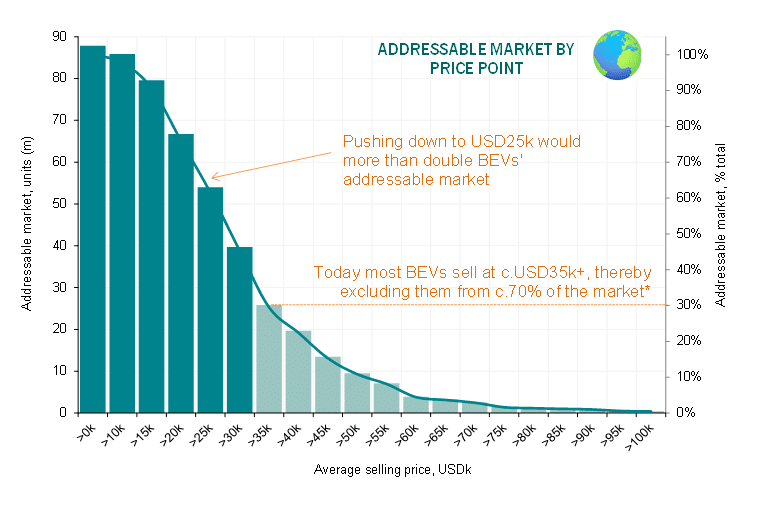Electric vehicles: the future of mobility in APAC
As electric vehicles help accelerate the automotive market towards a low-carbon future, how will APAC investors and businesses navigate the sector?
The electric vehicle revolution is well and truly under way, with five key drivers set to fuel the sector’s expansion over the years ahead.

Hailed as a critical element on the road to decarbonising transport, electric vehicles (EVs) continue to grow in popularity. The market for EVs held up during the pandemic, with resilient sales compared to traditional automotive markets.
Looking to the years ahead, BNP Paribas Exane expects a combination of increased subsidies globally, easing battery metals costs, and manufacturing scale to take battery electric vehicles (BEVs) to the mass market. Falling prices will enable US and EU players to move from luxury to mainstream price brackets, doubling the addressable market size and helping to drive the percentage of global electric vehicle sales up from 11% of the total in 2022 to just below 30% by 2026.


Companies, as well as consumers, are increasingly making the switch. In the recent Arval Mobility Observatory Fleet and Mobility Barometer 2022, 59% of companies surveyed said that they had already implemented or are considering implementing at least one type of clean energy vehicle – whether plug-in hybrid electric (PHEV), BEV or hybrid vehicle (HEV) – for passenger cars in their fleet, while 40% have at least one on fleet today.
While momentum is growing, a significant gap remains to achieve mass-market adoption. According to Arval BNP Paribas, companies surveyed still expect circa 55% of cars in their corporate fleet plans to be internal combustion engine (ICE) vehicles in the next three years.
At two of the largest mobility events in 2023 so far, Salon Autonomy and Drive to Zero, EVs were front and centre of the transition to cleaner and greener mobility, with BNP Paribas and industry experts discussing how to spur adoption. We explore five of the most important drivers to emerge.
Infrastructure, in particular access to charging points, stands out as a critical barrier to EV adoption.
At the BNP Paribas panel at Salon Autonomy, “Electromobility: Challenges, Solutions and Perspectives”, Joachim Reinboth, Co-Head of Automotive and Mobility Services at BNP Paribas CIB, set the scene: “The EV ecosystem is still very complex for consumers, who lack both knowledge and access to solutions that fit with their daily lives.”
Nastia Koro, Urban Mobility Expert and Founder of On Her Way agreed: “To see real change in customer mentality, buying an electric vehicle needs to be convenient. Consumers need to know they can get from A to B without issues. Charging infrastructure is still a major stumbling block.”
Current issues cited include the number of charging stations, leading to drivers’ ‘range anxiety’, or the fear of not having sufficient battery to reach a destination; the location and distance between charging points; the quality of chargers; and the length of charging time.

❝ To see real change in customer mentality, buying an electric vehicle needs to be convenient. Consumers need to know they can get from A to B without issues. Charging infrastructure is still a major stumbling block. ❞
According to research from BNP Paribas Exane, increased charging network density is key. With a broader network, original equipment manufacturers (OEMs) can sell more affordable BEVs with shorter ranges, and smaller, cheaper and faster-charging batteries, rather than resorting to larger, more costly batteries.
To accelerate the adoption of EVs, banks and financial institutions are key.
Reinboth explains: “Addressing some of these key pain points will require collaboration across the industry, from OEMs and suppliers to public authorities, investors, and banks as intermediaries to bridge financing needs. At BNP Paribas CIB, we are engaging with institutional investors around the future for EVs, connecting them with those in need of capital to accelerate the transformation of the industry.”
Philippe Jouglard, Head of Strategic Analysis & Projects, BNP Paribas Leasing Solutions, agreed: “We are slowly but surely seeing more and more charging projects, and it is clear that financing is and will be a key accelerating driver.”

❝ We are slowly but surely seeing more and more charging projects, and it is clear that financing is and will be a key accelerating driver. ❞
Andrian Cainarean, Head of Energy Transition at Arval noted: “Consumers need information and guidance, while companies are facing challenges to define the right business models. We see increased appetite from our corporate clients to move towards electrification, but they are asking for clear expert advice. The BNP Paribas Group, across its teams within Arval, Leasing Solutions and CIB, are here to help navigate this complexity.”

❝ Consumers need information and guidance, while companies are facing challenges to define the right business models. The BNP Paribas Group, across its teams within Arval, Leasing Solutions and CIB, are here to help navigate this complexity. ❞
Experts at the two events pointed to policy as a crucial accelerator for the EV market.
In 2022, the US implemented the Inflation Reduction Act (IRA), comprising US$370 billion in subsidies and tax credits. One of its key goals is to increase EV sales to 50% of total automotive sales in the USA by 2030, combining consumer policies such as tax credits, with manufacturing policies and supply chain incentives.
According to the International Council for Clean Transportation, for light-duty vehicles, the IRA’s incentives could help reduce purchase costs by between US$3,400 and US$9,050 over the 2023-2032 period. However, rules stipulating that EVs must be ‘Made in the USA’ to receive tax subsidies have drawn criticism from Europe, with concerns that it could affect OEMs.
The EU’s response to the Inflation Reduction Act has seen it focus on central policies to incentivise investment in the battery value chain and associated infrastructure. Additionally, on 28 March 2023, the European Council voted to approve new standards as part of its “Fit for 55” package, limiting the widespread sale of ICE cars and vans in the bloc by 2035.
Reinboth added: “We need automotive players to think differently, and form constructive partnerships – but policy levels must be right. We also need to show that there is a market to be financed, and then regulation and policy drivers will come around it.”
The road to mass adoption of electric vehicles continues to pose challenges for OEMs.
According to research from BNP Paribas Exane, the BEV price war already underway in China is set to go global, as increased subsidies, manufacturing scale and the easing price of battery metals drive down costs.
Stuart Pearson, Head of Thematic and Global Automotive Research at BNP Paribas Exane explains : “As competition spreads, capacity rises and costs fall, we see a deflationary era ahead for automotive pricing, at least in real terms, as the BEV war shifts to the mass market and spills over into ICE. The impact on OEMs is likely to be more chronic than acute; rather than a trough for margins in 2023, we instead expect a gradual margin fade over 2024 to 2026.”
According to Reinboth: “It is not enough to just put an electric engine in a traditional vehicle: the entire value chain must adapt to successfully stage the clean energy transition. Carmakers across the board are having to harness new technology and implement new commercial strategies in order to maintain a competitive advantage. ”
Both events had insights focused on the new technologies driving the market. Many experts agreed that price remains a barrier for consumers. While government subsidies can support consumers to an extent, continued technological enhancements such as improving performance and lowering the cost of batteries, can help make EVs more affordable and efficient for consumers.

❝ We are seeing a revolution in an industry that last underwent transformation a hundred years ago. We are at the point where the entire value chain needs to be replaced in order to become more sustainable. This means innovation, and knowledge sharing, between big players, as well as support to start-ups and scale-ups that are taking risks and bringing forth new ideas. ❞
Reinboth pointed to the massive technological shift under way. This includes innovations such as vehicle to grid (V2G), a technology that enables energy to be pushed back to the power grid from electric car batteries. He notes: “V2G has the potential to transform a depreciating asset into value creation, while supporting more balanced and sustainable energy systems.”
Reinboth concludes: “We are seeing a revolution in an industry that last underwent transformation a hundred years ago. We are at the point where the entire value chain needs to be replaced in order to become more sustainable. This means innovation, and knowledge sharing, between big players, as well as support to start-ups and scale-ups that are taking risks and bringing forth new ideas.”
Green mobility solutions across the value chain
The BNP Paribas Group aims to become the leading partner in mobility consulting and financing. BNP Paribas CIB partners with corporate clients on strategic advisory and financing solutions, and by connecting them with the right investors in a fast-moving landscape.
Working with CIB experts, BNP Paribas Arval and Leasing Solutions support businesses wishing to switch their corporate fleet and make new asset investments to more sustainable vehicles and machinery, such as tractors, construction equipment and trucks.
BNP Paribas delivers for clients across the whole EV value chain, including:
In 2023, the Bank acted as Exclusive Advisor, Joint Global Coordinator and Bookrunner in the IPO and pre-IPO funding round for Lhyfe, enabling the pioneering hydrogen company to accelerate the development of its production sites across Europe, to strengthen its business development and engineering teams in target geographies, and to pursue its investments.
BNP Paribas also acted as Financial Advisor to e-mobility pioneer BRUSA HyPowerAG on its private placement to Bosch Rexroth, M&G and Temasek. The investment aims to accelerate product development and scale manufacturing capabilities to meet the rising demand for energy conversion systems for fuel cell and battery electric vehicle applications.
A transformational partnership
In 2023, Jaguar Land Rover and BNP Paribas launched a suite of new mobility financing services across nine markets in Europe as part of their strategic partnership. The collaboration is the first phase of an ambitious plan to reimagine the role of financial services for clients of the automotive giant’s Range Rover, Defender, Discovery and Jaguar brands.
As electric vehicles help accelerate the automotive market towards a low-carbon future, how will APAC investors and businesses navigate the sector?
In the Netherlands' journey towards clean mobility, corporates are putting purpose at the heart of their efforts to drive the electrification of transport.
BNP Paribas does not consider this content to be “Research” as defined under the MiFID II unbundling rules. If you are subject to inducement and unbundling rules, you should consider making your own assessment as to the characterisation of this content. Legal notice for marketing documents, referencing to whom this communication is directed.